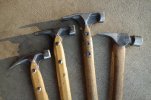I've been an EMT for 27+ years and I have tried/tested just about every seat belt cutter/rescue knife that any Fire/Rescue Gear salesman has tried to peddle to most fire departments.
In addition to handling/playing with them during sales pitches, we would also try them out under different scenarios during extrication training sessions. We would "trap" a firemen in the training vehicle before cutting the vehicle apart with a "Jaws of Life" unit with the seat buckled and then "free" the trapped firemen with different cutting tools to see what REALLY works best in cutting seat belts.
The BEST seat belt cutter in a non-life threatening situation where the belt catch refuses to open is the aforementioned Trauma Shears. It is appears non-threatening to a panicked crash victim stuck in their vehicle. The blunt tips preclude accidentally sticking your patient. Sticking a patient is one of those activities frowned upon by our medical director.
In an EMERGENCY Life-threatening situation with NO FLAMES INVOLVED, the lowly trauma shears is still the safest to use.
Throw in flames or the threat of flames (i.e., fuel leaking, smoke under the hood, active flames) a dedicated hooked seat belt cutter is the preferred tool. With no points, it is very easy to safely grab the stuck seat belt and rapidly cut the belt with a single pull of these knives.
A standard folding knife or fixed blade is the LAST choice for cutting seat belts in an emergency situation. Most standard folding or fixed blade knives have some sort of point that could pose a danger to your patients. Exceptions to this statement would be a folder or a fixed blade that has a VERY BLUNT "rope knife" style blade. No straight blade knife works as well as the dedicated hooked blade rescue knife.
I carry the following on my duty belt at all time:
2 pair of trauma shears,
2 hooked blade belt cutters,
1 spring loaded center punch
I have multiple reasons for 2 shears/2 seat belt cutters - the hinge pin on the shears can break, a mass casualty situation may require me to "loan out" some equipment to someone who doesn't have something, I may drop whatever I'm using into the floor well of the vehicle (gloves are clumsy) and I can't wait for someone to get another tool and pass it to me.
I also carry a pair of Kabar 3/4 shorties as my EDC fixed blades on my regular belt. (I don't take my EDCs off just to make an EMS call). The duty belt rests "OVER" the primary belt fixed blades, which helps hold the duty belt, which also has a radio, a pocket mask, glucose screening kit, and a latex glove carrier. I've used the fixed blades on multiple calls to pop vehicle tires to improve vehicle stability after collision.
I also have a spring loaded punch, a Gerber seat belt cutter and a pair of trauma shears velcroed inside the center console. Having something to cut with in the standard "dash located" glove box is useless if YOUR seat belt is stuck. Unless you have the arms of King Kong, you will never be able to reach over and open the glove box if your seat belt is stuck. The purpose for velcroing them in the console is so that they do not fall out in the event your vehicle also overturns. If they items are just sitting loose in the console, when upside down, the tools will just fall out and inevitably bounce some where inaccessible.
My trunk emergency kit tools consists of --
- a couple of extra spring punches
- 2 pairs of trauma shears,
- a BK2,
- a BK3,
- a machete,
- a hacksaw,
- a 15" bolt cutter,
- a 3# sledge
and
- a 10" cold chisel.
I've used these Gall's seat belt cutters for 25 years...
I buy these trauma shears cheaply off fleabay
And for the people who nay have never seen a spring loaded punch, or the Gerber strap cutter...



